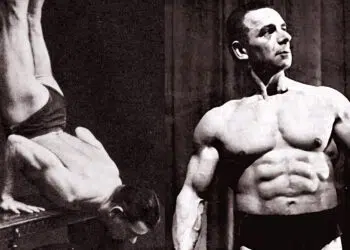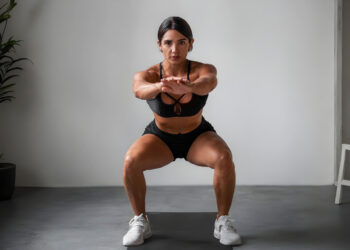I’m a long-time fan of bodyweight and calisthenic training. Bodyweight workouts were a cornerstone of my conditioning workouts as an athlete and a big part of my career in the Royal Marines. Decades later, I still use bodyweight training to stay fit and strong.
I also use a lot of bodyweight exercises with my personal training clients. This is despite having access to a state-of-the-art gym.
Why?
Because, for many people, bodyweight training offers advantages that weights cannot match. For example, you can do most calisthenic exercises anywhere and anytime, making them the perfect excuse-free workout. In addition, bodyweight exercises are often more joint-friendly and functional than their standard gym equivalents.
That doesn’t mean that lifting weights is inferior or bad. However, in some cases, bodyweight exercises are as good or even slightly better.
That said, conventional floor-based bodyweight exercises can become boring if that’s all you do. And that’s where suspension trainers (e.g., the TRX) come in. Suspension trainers make every bodyweight exercise better by adding an element of instability. They also increase your range of motion.
Level Up Your Fitness: Join our 💪 strong community in Fitness Volt Newsletter. Get daily inspiration, expert-backed workouts, nutrition tips, the latest in strength sports, and the support you need to reach your goals. Subscribe for free!
In addition, researchers found that suspension training compares favorably with conventional strength training (1). Consequently, you can confidently work out with a suspension trainer, safe in the knowledge you’ll get similar results compared to lifting weights.
In this article, I share seven of my favorite lesser-known suspension trainer exercises.
Unusual Suspension Trainer Exercises
Are you bored of doing the same old TRX exercises? I hear you! Here are seven of my favorite unusual suspension trainer exercises for full-body strength and conditioning.
1. Suspension Trainer Atomic Push-Up
Target muscles: Pectoralis major, deltoids, triceps, core, hip flexors.
Push-ups are one of the best upper body exercises on the planet. However, if you do them for a long enough time, they can become boring. That’s probably why some trainers think that push-ups are a beginner exercise. The suspension trainer atomic push-up breathes new life into this classic calisthenic exercise. It also makes them a whole lot harder!
How to do it:
- Adjust your suspension trainer handles so they’re about 12 inches above the floor.
- Place your feet in the handles and adopt the push-up position, hands roughly shoulder-width apart.
- Brace your core and draw your shoulders down and back.
- Flex your hips, lift your butt, and pull your knees into your chest.
- Extend your hips and return to the high plank position.
- Bend your arms and lower your chest to the floor.
- Extend your arms and return to the high plank position.
- That’s one rep – keep going!
Related: 5 Best TRX Chest Exercises (Plus Workout) For Bigger Chest Gains
Tips:
- Shorten the straps to raise your feet and put more weight on your arms.
- Use push-up handles or yoga blocks to elevate your hands and increase your range of motion.
- Wear a weighted vest to make this challenging exercise even harder.
2. Suspension Trainer Bulgarian Split Squat
Muscles worked: Quadriceps, hamstrings, gluteus maximus, abductors, adductors.
Bulgarian or rear foot elevated split squats are one of my favorite leg exercises. While they emphasize one leg at a time, increasing overload for a tougher workout, you get to use your non-working leg for balance, making them more accessible than true single-leg squats. Using a suspension trainer is a superb alternative to the more conventional bench.
How to do it:
- Adjust your suspension trainer to around knee height and stand with your back to it.
- Bend one leg and place your foot in the handle.
- Hop forward into a split stance.
- Bend your front leg and descend until your rear knee is an inch or so above the ground.
- Extend your front leg and stand back up.
- Continue for the required number of reps and then switch sides.
- Do the same number of reps on both legs.
Tips:
- Allow your rear leg to move naturally as you squat, but do not hyperextend your hip, as doing so could cause hip pain or injury.
- Hold dumbbells or wear a weighted vest to make this exercise more challenging.
- Place a chair in front of you and hold it for balance if required:
3. Suspension Trainer Pistol Squat
Muscles worked: Quadriceps, hamstrings, gluteus maximus, abductors, adductors.
While air squats are an effective calisthenic leg exercise, most people find them pretty easy. As such, they’re not much good for building strength. Switching to single-leg or pistol squats is a logical progression, but that’s a big jump, both in terms of load and technical difficulty. Suspension trainer pistol squats make this single-leg exercise easier and more accessible.
How to do it:
Level Up Your Fitness: Join our 💪 strong community in Fitness Volt Newsletter. Get daily inspiration, expert-backed workouts, nutrition tips, the latest in strength sports, and the support you need to reach your goals. Subscribe for free!
- Stand in front of your suspension trainer with a handle in each hand. Bend your elbows and pull your upper arms into your sides.
- Shift your weight over onto one leg and brace your core.
- Extending your non-working leg in front of you, bend your supporting knee and squat down as deeply as possible. Use your arms for balance and assistance.
- Drive your foot into the floor, stand back up, and repeat.
- Do the same number of reps on both legs.
Tips:
- Use your arms as little as possible. Make sure your legs do most of the work.
- Squat to a bench if you want to regulate the depth of each squat.
- This exercise is more manageable in flat-soled shoes or barefoot, as you’ll be more stable and less prone to losing your balance.
4. Suspension Trainer Bridge Row
Muscles worked: Gluteus maximus, hamstrings, latissimus dorsi, trapezius, rhomboids, rear deltoids, biceps.
Prolonged sitting can ruin your posture, and it’s not good for your health, either (2). Sitting weakens the muscles on the back of your body while shortening those on your front. The suspension trainer bridge row reverses this effect by strengthening your entire posterior chain and stretching your hips, abs, and quads. As such, they’re the perfect sitting antidote.
How to do it:
- Adjust your suspension trainer so the handles are about hip height.
- Sit on the floor below your suspension trainer and hold the handles. Pull your shoulders back and down, and extend your arms.
- With your legs bent and feet flat, lift your hips and adopt the bridge position. Make sure your glutes and core are engaged.
- Bend your arms and pull your shoulders up to the handles.
- Extend your arms and repeat.
Tips:
- Lead with your elbows and drive them back to maximize upper-body muscle engagement.
- Keep your chest up and your shoulders back throughout.
- Make this exercise harder by bridging on one leg only:
Related: Best TRX Back Exercises For a Thick Rock-Solid Back
5. Suspension Trainer Archer Push-Up
Target muscles: Pectoralis major, deltoids, triceps, core, hip flexors.
Archer push-ups are an excellent stepping stone toward mastering the one-armed push-up. They load one arm more than the other, making them an effective way to overload your chest, shoulders, and arms with just your body weight. Doing archer push-ups on a suspension trainer makes this popular calisthenic movement even more effective.
How to do it:
- Adjust your suspension trainer handles to around waist height.
- Grip the handles and adopt the push-up or high-plank position. Brace your core and pull your shoulders back and down.
- Shift your weight onto one arm, bend your elbow, and lower your chest toward the floor. Simultaneously extend your other arm out to the side. Only a small proportion of your weight should be on the extended arm.
- Return to the starting position, switch sides, and repeat.
Tips:
- Do all your reps on one side before switching, or use an alternating arm action as preferred.
- Shorten your straps to put your body into a more vertical position and make this exercise easier.
- Place your feet on a bench or lengthen the straps to make suspension trainer archer push-ups more challenging.
6. Suspension Trainer Rollout
Target muscles: Core, latissimus dorsi.
Many exercisers are familiar with rollouts, but have you ever done them using a suspension trainer? No? Well, you are in for a treat! I believe that it takes much more effort to control free-moving straps than a wheel rolling along the floor. In my opinion, and that of my personal training clients, suspension trainer rollouts are much more challenging than the conventional version. So, try ’em – I think you are going to like ’em.
How to do it:
- Set your suspension straps so the handles are a few inches above the ground.
- Kneel down and hold the handles with your arms straight and vertical.
- Press your weight down into the handles and brace your core. Round your lower back slightly to maximize abs engagement.
- Keeping your arms straight, push the handles out in front of you and lower your chest toward the floor.
- Use your abs to pull you back to the vertical position.
- Continue for the prescribed number of reps.
Tips:
- Stop your set if you feel this exercise in your lower back.
- Shorten the straps to make this exercise easier.
- You can also do rollouts from standing, but that is MUCH harder:
7. Suspension Trainer Power Pull
Target muscles: Latissimus dorsi, trapezius, rhomboids, deltoids, biceps, core.
Most suspension trainer exercises are done with a controlled tempo. This helps eliminate momentum and ensures that your muscles are under tension from the start of each rep to the finish. In contrast, you do this rowing exercise explosively, which increases muscle power. Power is your ability to generate force quickly and is a critical part of most sports.
How to do it:
- Set your suspension trainer handle to about waist height.
- Sit on the floor below it with your legs bent and feet flat. Grab the handle and lift your upper body off the floor. Brace your core and pull your shoulders back and down.
- Explosively bend your arm and pull yourself up toward the handle. Simultaneously reach up the strap with your opposite arm, aiming to get your hand as high as possible.
- Extend your arm and return to the starting position.
- Repeat for the desired number of reps and then switch sides.
Tips:
- Shorten the strap to make this exercise easier.
- Drive your elbow back as hard as possible to maximize muscle engagement.
- Touch the floor with your free hand between reps to ensure your range of movement remains constant throughout your set.
Closing Thoughts
Suspension trainers are the ideal solution for home exercisers looking to take their bodyweight workouts to the next level. As well as making things like push-ups and rows more challenging, you can replicate most cable and resistance machine exercises with one of these training tools.
In addition, there are plenty of unique suspension trainer exercises that you can’t really do any other way. These unusual movements challenge your muscles, joints, core, and balance, making them super-effective and time-efficient.
So, don’t get stuck in a suspension trainer rut, doing the same old exercises over and over. Instead, use the seven movements in this article to breathe new life into your workouts. Your body and mind will thank you!
References:
- Maté-Muñoz JL, Monroy AJ, Jodra Jiménez P, Garnacho-Castaño MV. Effects of instability versus traditional resistance training on strength, power, and velocity in untrained men. J Sports Sci Med. 2014 Sep 1;13(3):460-8. PMID: 25177170; PMCID: PMC4126279.
- Dunstan DW, Howard B, Healy GN, Owen N. Too much sitting–a health hazard. Diabetes Res Clin Pract. 2012 Sep;97(3):368-76. doi: 10.1016/j.diabres.2012.05.020. Epub 2012 Jun 9. PMID: 22682948.








